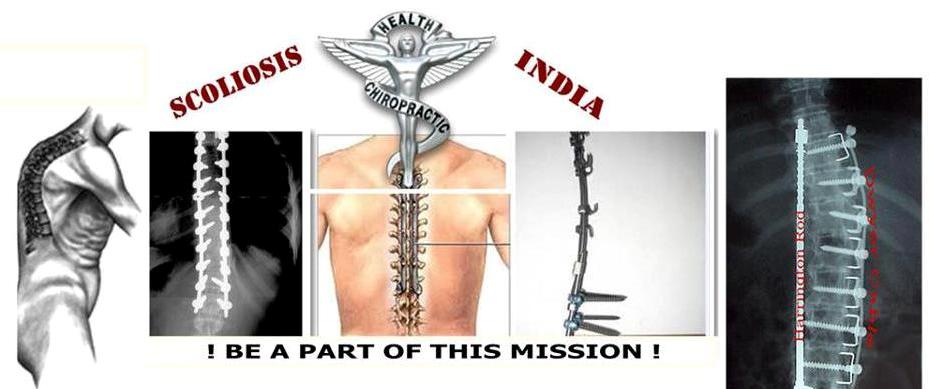Claire Holliday’s spine one year prior to the major back surgery she had
as a ninth grader. It’s amazing that she’s a swimming state
championship contender about four years later.
Photo courtesy of Claire Holliday
Read more here: http://www.heraldonline.com/sports/high-school/article39299952.html#storylink=cpy
If Claire Holliday places in the top-three Saturday at the 3A state
championship swim meet in Columbia, she’ll stand straighter and taller
than anyone else on the podium. Metal rods supporting Holliday’s spine
give her a very un-teenage-like upright posture.
Holliday will
compete in her final high school swim meet at the University of South
Carolina’s natatorium. She is seeded second in the 200-meter freestyle
and second in the 200-meter backstroke, the highest she has ever been
seeded at a state swim meet.
That she is able to swim at all is a testament to her hard work to return from a life-changing operation.
Holliday
was 8 years old when she learned she had scoliosis of the spine. But
the condition didn’t stop her from being an All-Region and
state-qualifying swimmer as a middle schooler for the South Pointe High
School swim team.
In the summer before her ninth grade year, Holliday underwent back
surgery in an effort to correct the condition. Her spine was curved in
two different places, an s-curve. Scoliosis results in either an s-curve
or a c-curve – exactly what it sounds like – with the s-curve that
afflicted Holliday being the worse of the two.
Holliday’s worst
pain surfaced in the year leading up to the surgery. She was limited in
swim practices and meets because of the aching caused by scoliosis. The
spinal curving was also worsening. Doctors first suggested that she wear
a back brace at that time, but it did not help.
Having scoliosis
was no surprise for Holliday; her mother and older sister both have the
condition. Holliday’s mom, Lou Ellen, had surgery when she was 13 years
old, so she understood what her daughter would have to endure.
My heart sank and ached as they wheeled her away for her surgery.
Lou Ellen Holliday
“At
age thirteen I experienced the same surgery. I was hopeful, though,
because the surgery is much less invasive now than when the procedure
was done for me,” said Lou Ellen.
In the summer of 2012, Holliday
underwent an eight-hour surgery at the Medical University of South
Carolina in Charleston. Doctors removed some of the joints between the
different bones of the spine and replaced them with cadaver bones, bones
donated by others after death. Holliday’s spine was then fused together
with a mix of existing bone and the cadaver bones. The spinal curve was
straightened by two metal rods and 20 to 30 screws.
Once the
bones were fused together the rods were no longer needed, but remained
in place due to the complication of the surgery. Holliday now stands
5-foot-8, three inches taller than she was before the surgery. She still
has a slight curve in her spine because the surgery could not
straighten it completely.
“I have back pain all the time still,” she said. “But it’s not like it was before.”
Holliday
was confined to her bed for about two months after surgery, except for
when she would go to the pool, this time for therapy, where she would
attempt to walk in the water. Doctors had her walk to the end of her
driveway each day, but even that was difficult. She says it took about a
year to get back to swimming competitively again.
Swimming aside, Holliday had to relearn the basic activities of daily living.
“For
a couple months I couldn’t walk by myself,” she said. “I couldn’t use
the bathroom, I couldn’t take a shower, I couldn’t even stand up.”
Returning to the pool – for any reason – was a relief.
“As
soon as I was able to, I was there every single day, I didn’t miss a
practice, because I wanted to get better,” Holliday said.
--------------------------------------------------------------------------------------------------------
At the 2014 3A swimming state championship, Claire Holliday finished third in the 200 IM and fifth in the 100 backstroke.
Read more here: http://www.heraldonline.com/sports/high-school/article39299952.html#storylink=cpy
--------------------------------------------------------------------------------------------------------
Scoliosis still affects her swimming today. She doesn’t typically
swim butterfly or breast stroke anymore because those strokes bother her
back. Her best strokes have always been freestyle and backstroke
anyway.
Last summer Holliday went to the YMCA National
Championships in Indianapolis and placed 15th in the 200-meter
backstroke, the highest she has ever placed individually at Nationals.
She’s also thinking about pursuing college swimming.
Scoliosis did
have an inadvertent positive impact. Holliday thinks she wouldn’t have
worked as hard in competitive swimming without the operation, and the
therapy that followed.
“Her positive outlook on life helps to keep
an occasional back pain from keeping her down,” said Holliday’s mother.
“She is stronger than she was before the surgery.”
Source : Herald Online , 15th Oct 2015
Read more here: http://www.heraldonline.com/sports/high-school/article39299952.html#storylink=cpy
Read more here: http://www.heraldonline.com/sports/high-school/article39299952.html#storylink=cpy

